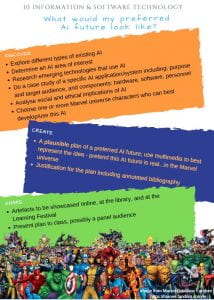 I’m not gonna lie. When DTHub asked if I could share my story about a recent PBL unit with IST, I squealed with excitement. Validation, right? Usually I just share here but DT Hub has a much bigger audience than my blog!
I’m not gonna lie. When DTHub asked if I could share my story about a recent PBL unit with IST, I squealed with excitement. Validation, right? Usually I just share here but DT Hub has a much bigger audience than my blog!
The story is up – What would my preferred AI look like? There’s no point re-posting here so please go there to read the story, download resources including assessment task details, and view exemplars – plus some tips on adjustments you can make to it.
I was excited planning this PBL and tweeted this poster on the left a lot. Running it got frustrating at times – as projects sometimes (often?) do. But the students engaged, and persevered, and rose above feelings of confusion and frustration. The result was a triumph in teaching and learning which I was glad and proud to share more widely.
The story in DT Hub is not complete though. There are more awesome stories to tell, e.g.
- a student who previously struggled with completing assessments on time, if at all, did so this time
- a student who spent an inordinate amount of time on one aspect of the project, to the detriment of some of her other subjects reminds me that, like adults, students juggle and prioritise and will go beyond expectations when motivated by personal interests (that’s a long sentence!)
- a recent Twitter connection, Erica Southgate, whom I’ve not personally met (yet) connected ESA/DTHub and me. What little she knew of my work, she thought good enough to be worth sharing. Awesome, right?
- some parents of these girls told me how it opened up interesting discussions at home AND some even offered opportunities like excursions and connections to other IT professionals. Yay!
- the hope @smerity gave us regarding ‘dual use technology’ such as AI: while we cannot eliminate the bad, maybe we can drown it out with the good. As a tech teacher, I live for this hope, that my students will believe they can help build a preferred future (yes, I’m assuming it is good)!
That last point is a salient one and the reason for the blog post title. There are so many negative stories around and it’s important to share positive ones. I really believe that everyone has awesome stories to share: face-to-face or online.
We all need to share more of the good stuff because this is the stuff that gives us – and our students – hope for a better future, and that education can help us get there. I think this quote I shared on my post about (action-research on) hope is appropriate to re-share:
…if openly shared and freely distributed, hope can spread throughout the community. – James Arvanitakis
#ShareTheAwesome
Someone gifted me this perspective a while ago as I battled with impostor syndrome (this nasty voice inside that refuse to just leave me alone for good). Putting this video here again in case you need it to be convinced that you have something awesome to share. We all do.

